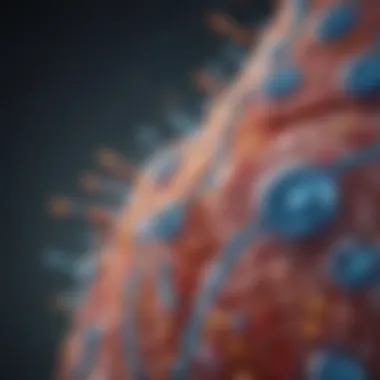Exploring the Pancreatic Network: Structure and Function


Intro
The pancreas is a pivotal organ in the human body, playing a significant role in digestive health and metabolic processes. Within its structures, various cell types converge to ensure the proper functioning of bodily systems. This exploration into the pancreatic network seeks to unravel its complex architecture, its essential functions, and the consequences of its dysfunction on overall health. It is paramount for both medical practitioners and researchers to understand the intricacies of this organ, as it underpins critical health outcomes.
In this article, we will examine the anatomy of the pancreas, emphasizing the relationships among its many components. Furthermore, we will delve into how the pancreas regulates insulin and assists in digestion through its array of enzymes. Additionally, we will highlight the current research concerning pancreatic diseases and their impact on health. A detailed understanding of these elements serves not only to bolster medical knowledge but also to guide therapeutic developments.
By shedding light on the pancreatic network, this exploration aims to educate readers about the fundamental roles this organ plays, along with its wider implications for health and disease.
Prelims to the Pancreatic Network
Understanding the pancreatic network is vital for grasping how human health is maintained through complex biological interactions. The pancreas plays a crucial role not only in digestion but also in regulating blood sugar levels. These dual functions - exocrine and endocrine - highlight the significance of the pancreatic structure. By exploring its anatomy and functions, we can uncover both the normal operation and the potential dysfunctions that lead to serious health issues.
Definition and Importance
The pancreas is a glandular organ situated behind the stomach, primarily involved in digestion and the regulation of blood glucose. Defined as an organ that has both endocrine and exocrine functions, it consists of different regions responsible for hormone release and enzyme secretion. Its importance cannot be overstated, as it affects systems such as digestive health and metabolic processes.
The pancreas produces essential hormones such as insulin and glucagon. These hormones work together to control glucose metabolism. This fine-tuning of energy levels is critical to prevent disorders like diabetes mellitus, which can arise due to pancreatic malfunction. A thorough understanding of these functions provides insight into how various diseases develop and may offer avenues for innovative treatments.
Overview of Pancreatic Anatomy
The anatomical organization of the pancreas contributes significantly to its multifaceted role in the body. It consists of distinct anatomical sections: the head, body, and tail, each participating in specific functions.
- Head: The wider part, which is connected to the duodenum through the pancreatic duct. Here, digestive enzymes are delivered to assist in breaking down food.
- Body: This central section houses clusters of hormone-producing cells called islets of Langerhans. These clusters are vital for glucose regulation and overall metabolic homeostasis.
- Tail: The tapered end of the pancreas, which extends toward the spleen. Although less involved in digestion, the tail plays a role in hormone production.
The interconnecting duct system presents another layer of sophistication. The pancreatic duct transports enzymes from acinar cells through the main duct, converging with bile ducts before entering the small intestine. This anatomy illustrates how the pancreas effectively serves as both a digestive and hormonal organ, underscoring its indispensable contribution to overall health.
"Understanding the pancreatic network helps illuminate its role in critical bodily processes and its influence on various diseases."
In summary, the pancreatic network stands at the intersection of digestion and hormonal control. Recognizing its structure and function sets the stage for deeper exploration into health implications and emerging research surrounding pancreatic diseases.
Anatomical Overview of the Pancreas
The anatomical structure of the pancreas plays a crucial role in its diverse functions. Understanding this structure allows for better insights into not only how the pancreas operates but also the implications of its dysfunction. The pancreas is both an endocrine and exocrine organ, and its anatomy reflects these dual functions. This overview will focus on the various components of the pancreas, emphasizing how each part contributes to the overall function and health of the organism.
Pancreatic Lobules and Ducts
The pancreas consists of lobules that are separated by connective tissue. These lobules contain clusters of cells, with duct systems interspersed throughout. The architecture of the pancreatic lobules is essential because it facilitates the organization of both endocrine and exocrine functions.
The main pancreatic duct transports digestive enzymes produced by the acinar cells to the duodenum. Blockage in this duct can result in serious health issues such as pancreatitis or digestive disorders.
Cell Types and Their Functions
The pancreas has several specific cell types that contribute to its functions. Each cell type is instrumental in maintaining glucose homeostasis and proper digestion.
Alpha cells
Alpha cells, located in the islets of Langerhans, are primarily responsible for the secretion of glucagon. This hormone plays a pivotal role in raising blood glucose levels when they fall too low.


A key characteristic of alpha cells is their responsiveness to low glucose levels. This makes them essential for regulating energy intake and expenditure. However, excessive glucagon release can contribute to insulin resistance, which complicates glucose metabolism.
Beta cells
Beta cells are another critical component of the pancreatic network. They produce insulin, which lowers blood glucose levels. The secretion of insulin is finely tuned based on the glucose concentration in the blood.
A notable trait of beta cells is their ability to increase insulin release in response to high blood sugar. This action is significant for maintaining energy balance. However, their dysfunction is a hallmark of type 2 diabetes, emphasizing their importance in glucose regulation.
Delta cells
Delta cells secrete somatostatin, which has an inhibitory effect on both glucagon and insulin secretion. This regulatory function makes delta cells a crucial component in maintaining endocrine balance in the pancreas.
Their predominant feature is their ability to act as modulating agents within the hormonal landscape of the pancreas. However, an imbalance in somatostatin levels can lead to disrupted metabolic processes.
Acinar cells
Acinar cells specialize in producing digestive enzymes, including amylase, lipase, and proteases. Their contribution is vital to the digestive process. When food enters the duodenum, these enzymes facilitate the breakdown of macromolecules.
A unique feature of acinar cells is their production of zymogens, which are inactive enzyme precursors. This characteristic is crucial to prevent self-digestion of the pancreas. Nevertheless, if the regulation of these enzymes is disrupted, it can lead to conditions such as pancreatitis.
Vascularization of the Pancreas
The vascularization of the pancreas is essential for its various functions. Blood vessels transport hormones and nutrients to and from the pancreatic cells. The rich blood supply ensures that both endocrine and exocrine tissues receive adequate nourishment.
The pancreas receives blood through the splenic artery, the superior mesenteric artery, and the gastroduodenal artery. This arrangement ensures that ample blood flow supports the metabolic and digestive activities of the pancreas.
In summary, an understanding of the anatomical structure of the pancreas, including its lobules, ducts, diverse cell types, and vascularization, is vital. This knowledge serves as a foundation for comprehending pancreatic function and its implications for health.
Functional Dynamics Within the Pancreatic Network
Understanding the functional dynamics within the pancreatic network is essential. The pancreas plays a central role in metabolism. It regulates blood sugar levels through hormones like insulin and glucagon. Also, pancreatic enzymes are critical for digestion. These processes illustrate the balance and integration of functions within the pancreas. This section explores these dynamics in detail, revealing their importance in maintaining overall health.
Hormonal Regulation of Blood Sugar
Insulin Secretion Mechanisms
Insulin is key to managing blood sugar levels. The beta cells in the islets of Langerhans are responsible for producing insulin. When blood glucose levels rise, these cells secrete insulin into the bloodstream.
The mechanism of insulin release can be described as follows:
- Glucose enters beta cells through specific transporters.
- Inside the cells, glucose undergoes metabolism to produce ATP.
- The rise in ATP closes K+ channels, leading to cell depolarization.
- This depolarization opens voltage-gated Ca2+ channels, allowing calcium ions to enter the cell.
- The influx of calcium triggers the exocytosis of insulin-containing granules.
This precise mechanism is fundamental for maintaining homeostasis. A key characteristic of insulin secretion is its feedback loop. When blood sugar levels stabilize, insulin secretion decreases. This property makes it a significant aspect for consideration in metabolic health. However, disturbances in secretion can lead to metabolic disorders such as diabetes.
Glucagon Functions
Glucagon has a contrasting role to insulin. Produced by alpha cells, glucagon raises blood glucose levels by promoting gluconeogenesis and glycogenolysis in the liver. When blood sugar levels fall, glucagon secretion increases, stimulating the liver to release glucose into the bloodstream.
Some notable points about glucagon functions are:


- Response to Low Glucose: Glucagon acts when energy levels drop, showcasing the body's regulatory capacity.
- Action in the Liver: It directs the liver to convert stored glycogen back into glucose.
- Quick Regulation: Glucagon acts rapidly, ensuring that the body has necessary energy supplies.
The unique feature of glucagon is its role in counteracting hypoglycemia. Understanding how glucagon operates is critical for grasping the balance within the pancreatic network. Both glucagon and insulin are vital for homeostasis.
Role of Enzymes in Digestion
The pancreas secretes a variety of digestive enzymes that break down macromolecules in the food we consume. These enzymes include amylase, lipase, and proteases.
Amylase aids in carbohydrate digestion by breaking down starches into sugars. Lipase is essential for fat breakdown, while proteases digest proteins into smaller peptides. Each enzyme has specific functions that align with the processes in the digestive system.
The release of these enzymes occurs in response to food intake. When food enters the small intestine, it triggers hormonal signals, primarily secretin and cholecystokinin. These hormones stimulate the pancreas to release the necessary enzymes.
The importance of pancreatic enzymes cannot be overstated:
- They facilitate nutrient absorption, making nutrients available to the body.
- They help maintain digestive pH levels by neutralizing stomach acid.
- This efficient digestion prevents malnutrition and supports overall health.
In summary, the functional dynamics within the pancreatic network are vital for both energy regulation and effective digestion. The interplay between insulin, glucagon, and digestive enzymes exemplifies the complexity of this organ's role in health.
Intercellular Communication in the Pancreatic Network
Intercellular communication is a critical aspect of the pancreatic network, influencing both its structural integrity and functional dynamics. The pancreas consists of a variety of specialized cell types that must work in concert to maintain homeostasis. These cells exchange information through various signaling mechanisms, which ensures proper functioning of the organ. Understanding how these interactions take place can shed light on the health and disease states of the pancreas.
Signaling Pathways
Communication within the pancreatic network relies heavily on intricate signaling pathways. These pathways facilitate the transfer of information between different cell types, allowing them to respond to physiological changes. For example:
- Hormonal Signaling: Hormones like insulin and glucagon are secreted by pancreatic cells, acting as messengers that inform other cells about blood glucose levels. This hormonal communication is crucial for maintaining glucose homeostasis.
- Paracrine Signaling: Localized signal molecules, released by one cell, act on adjacent cells. Somatostatin, secreted by delta cells, inhibits the release of insulin and glucagon, demonstrating a regulatory feedback mechanism to fine-tune endocrine functions.
- Autocrine Signaling: Cells can also influence their own operation through intricated feedback loops. Alpha cells may respond to their own secreted glucagon, modulating their own activity based on surrounding glucose levels.
Through these signaling pathways, the pancreas can rapidly adjust its enzymatic and hormonal outputs in response to the body’s changing needs.
Impact of Local Microenvironment
The local microenvironment plays an essential role in intercellular communication within the pancreatic network. Factors within this microenvironment can significantly influence cellular behavior and communication effectiveness. Consider the following points:
- Extracellular Matrix (ECM): The ECM provides structural support to pancreatic cells and also facilitates communication through its composition. Proteins and glycoproteins in the ECM can bind with cell surface receptors, triggering intracellular signaling pathways that affect cell growth, differentiation, and survival.
- Cell-Cell Interactions: Cells in close proximity can communicate through direct contact. Gap junctions allow ions and small molecules to pass directly between cells, enabling rapid signaling and coordination of responses.
- Infiltration of Immune Cells: The pancreatic microenvironment can be impacted by immune cells, particularly during inflammation. The presence of these cells can alter the signaling dynamics, leading to changes in hormone secretion or potentially contributing to diseases like pancreatitis.
The interaction of these components forms a dynamic network that is essential for proper pancreatic function. Understanding these elements can aid in comprehending how disruptions in communication contribute to diseases such as diabetes and pancreatitis.
Pathophysiology of the Pancreatic Network
Understanding the pathophysiology of the pancreatic network is essential for grasping how dysfunction within this complex organ impacts overall health. The pancreas contributes not only to digestion but also to critical metabolic processes such as blood sugar regulation. When the function of the pancreas deteriorates, it can lead to severe health issues, including diabetes, pancreatitis, and pancreatic cancer. These conditions are not just isolated problems but often interlinked, highlighting the need for a comprehensive understanding of pancreatic pathophysiology.
Medical professionals and researchers benefit from exploring these dysfunctions. By understanding the underlying mechanisms, new therapeutic strategies can be developed. A more nuanced view of the pancreatic network sheds light on potential prevention strategies, thereby improving health outcomes for patients.
Diabetes Mellitus and Insulin Resistance
Diabetes mellitus is a key area where pancreatic dysfunction is highly evident. There are two main types of diabetes: Type 1 and Type 2. In Type 1 diabetes, the immune system mistakenly attacks and destroys insulin-producing beta cells in the pancreas. This leads to a complete deficiency of insulin, requiring lifelong insulin therapy for management.
Type 2 diabetes presents a different scenario. This type often stems from insulin resistance, where cells become less responsive to insulin. Over time, the pancreas struggles to produce adequate insulin, leading to a range of complications. Insulin resistance can be influenced by various factors, including nutrition, physical inactivity, and genetic predisposition.
The implications of diabetes are profound. Long-term hyperglycemia can lead to complications such as cardiovascular disease, kidney dysfunction, and neuropathy. Therefore, understanding diabetes in the context of the pancreatic network is critical for developing interventions and management strategies.


Pancreatitis: Types and Consequences
Pancreatitis refers to inflammation of the pancreas, and it can be categorized into acute and chronic forms. Acute pancreatitis often arises suddenly and is usually the result of gallstones, excessive alcohol consumption, or certain medications. Symptoms may include severe abdominal pain, nausea, and vomiting. In many cases, acute pancreatitis resolves with medical treatment, but it can become serious and lead to complications like organ failure.
Chronic pancreatitis, on the other hand, is a long-lasting condition that results from repeated episodes of inflammation. This leads to permanent damage to the pancreas, affecting its ability to secrete digestive enzymes. Patients may suffer from chronic pain, malnutrition, and diabetes as a result of the ongoing damage. The consequences of chronic pancreatitis can significantly impact quality of life, necessitating ongoing medical management and lifestyle changes.
Pancreatic Cancer: Mechanisms of Tumorigenesis
Pancreatic cancer is one of the most aggressive malignancies and the pathophysiology is complex. The most common type of pancreatic cancer is pancreatic adenocarcinoma. A variety of genetic and environmental factors contribute to tumorigenesis, including mutations in specific genes such as KRAS, TP53, and CDKN2A. These mutations often lead to the uncontrolled growth of cells within the pancreas.
Early detection of pancreatic cancer is challenging due to the lack of specific symptoms in its initial stages. As a result, many cases are diagnosed at advanced stages, where treatment options are limited. Understanding the mechanisms behind pancreatic tumorigenesis can help in developing better diagnostic tools and targeted therapies. Greater awareness and research on the pathophysiological mechanisms are critical steps toward improving patient outcomes in pancreatic cancer.
The interconnectedness of pancreatic diseases emphasizes the importance of a holistic approach to understanding its pathophysiology.
In summary, a comprehensive exploration of the pathophysiology of the pancreatic network reveals critical insights into its role in health and disease. Addressing dysfunctions such as diabetes, pancreatitis, and cancer can significantly contribute to advancements in treatment and management strategies.
Emerging Research in Pancreatic Health
Emerging research in pancreatic health is pivotal in expanding our understanding of this vital organ. Recent studies highlight new therapeutic methods and genetic insights, which are essential for addressing pancreatic dysfunctions. The relevance of this research cannot be understated. It provides fresh perspectives on diseases such as diabetes and pancreatitis. By exploring these innovative avenues, we can better comprehend the complexity of pancreatic disorders and improve patient outcomes.
Innovative Therapeutic Approaches
Recent advancements in pancreatic health demonstrate significant potential in therapeutic interventions. Researchers are investigating a range of innovative treatments designed to combat pancreatic diseases. Some noteworthy approaches include:
- Targeted Drug Therapies: These focus on specific pathways within pancreatic disorders, aiming to reduce side effects and enhance efficacy.
- Stem Cell Research: Using stem cells presents opportunities for regenerating damaged pancreatic tissues, particularly in diabetes treatment.
- Gene Therapy: This method looks to correct genetic anomalies that contribute to pancreatic illnesses, offering a long-term solution.
- Microbiome Studies: The role of gut health on pancreatic function is gaining attention, with studies suggesting that manipulating gut bacteria may influence pancreatic health.
Research in this area is still in early stages, but early results indicate promise. Each of these approaches holds potential for improving treatments and impacting patient quality of life positively.
Genetic Studies and Their Implications
Genetic studies in pancreatic health have revealed essential insights into the heritability and risk factors associated with pancreatic diseases. Key findings in this area include:
- Understanding Genetic Predisposition: Identifying genes linked to conditions like pancreatic cancer and diabetes can help in early diagnosis and treatment.
- Family History Considerations: Genetic profiles can assist in evaluating family histories, which is crucial for risk assessment.
- Biomarkers Development: Genetic testing may lead to the identification of biomarkers useful for monitoring disease progression.
These genetic insights are crucial for targeted interventions. They can lead to personalized treatment strategies that take individual variations into account. As research progresses, the implications for future therapies will continue to unfold, informing both clinical practices and preventive strategies in pancreatic health.
This body of work is vital in transforming how we address pancreatic disorders, paving the way for preventative measures and more effective treatments in the coming years.
Concluding Thoughts on the Pancreatic Network
The pancreatic network plays a pivotal role in maintaining homeostasis within the human body. Throughout this article, we have explored the multifaceted structure and function of the pancreas and its components. Understanding the intricate relationships between cell types, signaling pathways, and their contributions to vital functions offers essential insights into both health and disease.
Summary of Key Points
The following key points encapsulate the principal insights presented in this article:
- The pancreas consists of diverse cell types, including alpha cells and beta cells, each with distinct functions crucial for hormonal regulation.
- Insulin and glucagon work together to maintain blood sugar levels, highlighting the importance of hormonal balance.
- The role of digestive enzymes produced by acinar cells is vital for nutrient breakdown and absorption, which is fundamental for overall health.
- Pathophysiological conditions, like diabetes mellitus and pancreatitis, underscore the consequences of pancreatic dysfunction and its implications for patient care.
- Ongoing research is uncovering innovative therapeutic approaches and genetic insights that could reshape our understanding of pancreatic diseases.
This synthesis emphasizes the significance of the pancreas in various health contexts, offering a framework for further investigation and intervention.
Future Directions in Research
As we look to the future, several key areas of research hold promise for advancing our understanding of the pancreatic network:
- Regenerative Medicine: Investigating stem cell therapies to repair or replace damaged pancreatic cells could lead to novel treatments for diabetes and other disorders.
- Genomic Studies: Expanding genetic research will help identify risk factors for pancreatic diseases, aiding in early detection and personalized treatment approaches.
- Microbiome Relations: Understanding how gut microbiota interacts with pancreatic function may reveal new insights into digestive health and glucose metabolism.
- Innovative Drug Development: The pursuit of medications that more effectively target pancreatic functions may improve outcomes for patients suffering from related diseases.







